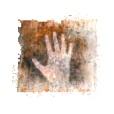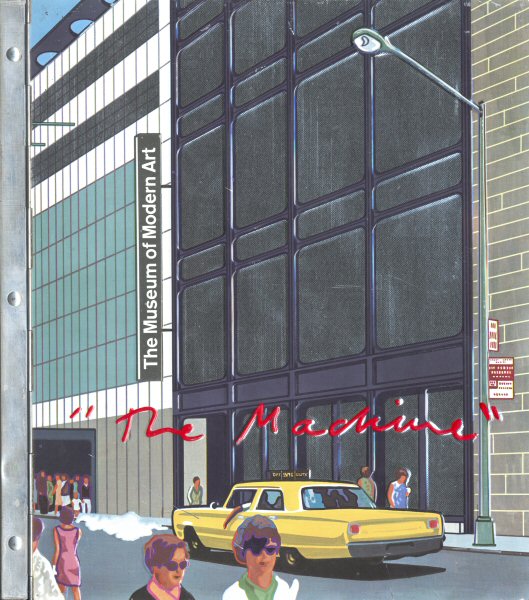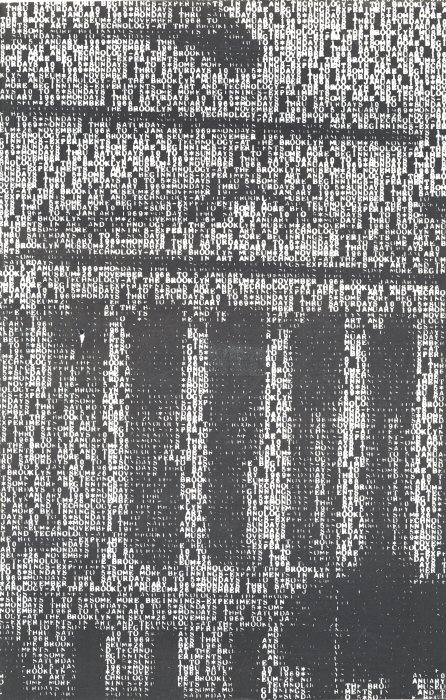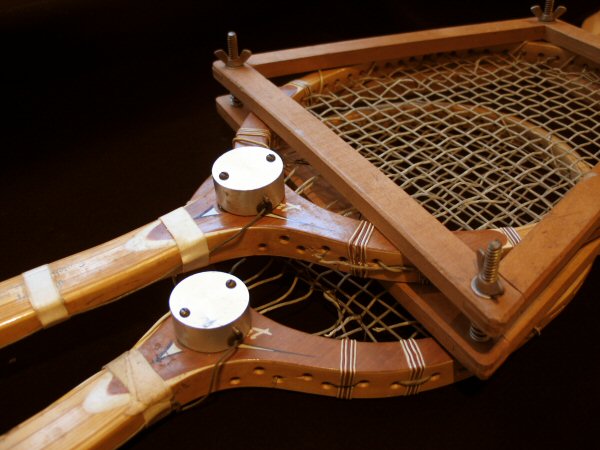Sylvie Lacerte
9 Evenings and Experiments in Art and Technology
A gap to fill in art history's recent chronicles
“Information presented at the right time and in the right place can potentially be very powerful. It can affect the general social fabric... The working premise is to think in terms of systems: the production of systems, the interference with and the exposure of existing systems... Systems can be physical, biological or social.” (1)
And one might add... technological!
When engineers Billy Klüver and Fred Waldhauer and artists Robert Rauschenberg and Robert Whitman founded Experiments in Art and Technology (EAT) in 1966, they had just emerged from 9 Evenings: Theatre and Engineering, a series of performances held at the 69th Regiment Armory in New York City, where, it is said, ten thousand people attended. (2) Although the performances received mixed reviews, the foursome didn't want the endeavour to end there. Their wish was to pursue the collaboration beyond the “event” to enable artists to make use of devices and advice that would have been beyond their reach without this type of joint venture.
What started all of this, beyond his friendship to countryman, curator and museum director Pontus Hulten, was Billy Klüver's collaboration with Jean Tinguely on his self-destructing machine Homage to New York, presented in the Museum of Modern Art's garden in New York on March 17, 1960. While working on Homage, Tinguely introduced Klüver to Robert Rauschenberg, who had agreed to participate in the edification of this suicidal installation with a work of his own entitled the Money Thrower, a box filled with gunpowder and twelve silver dollars, which exploded at one point in the process, sending the coins haywire into the garden. (3) Klüver subsequently collaborated with Rauschenberg on many of his works (Oracle, 1965; Soundings, 1968; Solstice, 1968; etc.) as well as with other artists, such as Jasper Johns (Field Painting, 1962; Zone, 1965), dancer Yvonne Rainer (At My Body's House, 1964), Andy Warhol (Silver Clouds, 1965-1966), composer John Cage and choreographer Merce Cunningham (Variations V, 1965), and many others.
While 9 Evenings was judged by many as a forced marriage between artists and engineers, the event became a fertile ground for the invention of a number of technological tools never before used in theatrical or live performance environments or for that matter in the commercial arena. These devices included, for example, sound captors concealed in the tennis racquets' handles, in Rauschenberg's performance Open Score, that eventually led to the invention of the wireless microphone. The TEEM (Theatrical Electronic Environmental Module), a remote and proportional control system designed to control and relay movement, sound and light effects in all of the performances, was another machine created solely for 9 Evenings. (4)
Above all, EAT became a tentacular service organization, whose mission was to facilitate the work of artists in any field or discipline. Klüver's wish was to find “new means of expressions for artists... and to find out where they stood in relation to the society that was sending men to the moon.” (5) EAT triggered the creation of many “chapters” across the US, Canada, Japan, France, England and India. Each one of these chapters produced an array of events, activities, newsletters and match-ups between artists and industry. And it all happened before globalization had become a buzzword.
So what happened? Why did a pregnant silence prevail around this apparently revolutionary organization that had helped create work for so many artistic icons through thought provoking interactions between artists and scientists?
Although several essays and articles were published about the events produced by EAT at the moment they took place, only a small number of anthologies on art and technology mention EAT, and these amount to a few succinct sentences that largely contain the same information. The most exhaustive works written on EAT were, among others, Pavilion, a book written by Billy Klüver in collaboration with art critic Barbara Rose and other contributors on the trials and tribulations and the making of the Pepsi Pavilion at the 1970 Osaka Universal Exhibition, as well as a descriptive doctoral dissertation by Norma Loewen on EAT's activities in 1975. (6) And while articles by Billy Klüver from the '60s and '70s have lately been reissued in a small number of publications, (7) and more recent texts by Klüver with Julie Martin have been edited in various books, catalogues or magazines, (8) not one comprehensive and contextual analysis of this phenomenon was ever undertaken, either in assessments dedicated to the art of the '60s and '70s or in a volume of its own. (9)
In the review of literature, I found factual inaccuracies that attribute, for example, links between EAT and the Art & Technology Program created by Maurice Tuchman at the Los Angeles County Museum of Art (LACMA) in 1967. Some consider EAT as a branch of LACMA's A&T program, while others assert that 9 Evenings was presented under EAT's umbrella, when to the contrary, the creation of EAT was a direct upshot of 9 Evenings. In fact, pour la petite histoire, the evening EAT was founded was dubbed “the 10th Evening” by Fred Waldhauer. But by far, the most notorious blunder stated: “In 1968 EAT created an exhibition at the Brooklyn Museum of Art and at the MoMA, called Some New Beginnings (10) (...) And the same year the MoMA presented The Machine as Seen at the End of the Mechanical Age. The most interesting and spectacular machine was without doubt Homage to New York by Jean Tinguely.” (11) This is most disconcerting indeed, bearing in mind that it is known and documented that The Machine was shown at the MoMA, with Some More Beginnings shown concurrently at the BMA. The latter was a showcase for all of the artist/engineer team projects entered in a contest launched by EAT and whose top ten contestants were exhibited in the Machine. Needless to say, it is unnecessary to comment on Tinguely's supposed participation in any of these exhibitions.
Sylvie Lacerte © 2005 FDL
(1) Jeanne Siegel, “An Interview with Hans Haacke,” Arts Magazine 45, no. 7 (May 1971); p. 21 as quoted in Six Years: The dematerialization of the art object from 1966 to 1972…/ edited and annotated by Lucy R. Lippard, (Berkeley/Los Angeles: University of California Press, 1997 (1973)) p. xiii.
(2) This event was originally planned for an Art and Technology Festival in Stockholm, Sweden. But as many financial problems arose, the event was cancelled, and Klüver and Rauschenberg decided nevertheless to take this risky enterprise to New York City. Simone Whitman, an artist herself and the wife of Robert Whitman, found the Armory as the site for 9 Evenings through her political connections.
(3) The coins were never found. Mary Lynn Kotz, Rauschenberg/Art and Life – New Edition (New York: Harry N. Abrams, 2004) p. 128.
(4) Unfortunately, the control over the lighting system in Open Score did not work as planned, and the lights had to be turned off manually, while the sound control worked perfectly.
(5) 9 Evenings : Theatre and Engineering (manuscript) / Harriet DeLong, Experiments in Art and Technology.-1966-1967 (1972-1973). Box 2. Experiments in Art and Technology. Records, 1966-1993, Research Library, The Getty Research Institute, Los Angeles, California (940003).
(6) Norma Loewen, Experiments in Art and Technology: A Descriptive History of the Organization (New York: New York University, 1975). Ph. D. dissertation delivered at the School of Education, Health, Nursing and Arts Professions, New York University, 1975.
(7) Among others, Billy Klüver, “Four Selections by Experiments in Art and Technology,” in The New Media Reader, Noah Wardrip-Fruin & Nick Montfort, Ed. (Cambridge/London: The MIT Press, 2003) pp. 211-227; Billy Klüver, Julie Martin, “Four Difficult Pieces,” Art in America (July 1991) pp. 80-99, p. 138.; Simone (Whitman) Forti, “Le théâtre et l'ingénierie – une expérience: Notes d'une participante,” Nouvelles de danse (2004) Title of issue : “Interagir avec les technologies numériques,” pp. 11-28 and Billy Klüver, “Le théâtre et l'ingénierie – une experience: Notes d'un ingénieur,” Nouvelles de danse (2004) pp. 29-35. Both texts were originally published in English in Artforum V, (February 1967).
(8) All are mentioned in the bibliography.
(9) On a more positive note, it should be pointed out that exhaustive research has been done recently on various aspects of EAT's activities by a few scholars.
(10) Underlined by the author
(11) Olivier Lussac, Happening & Fluxus – poly expressivité et pratique concrète des arts, Paris, L'Harmattan, 2004, p. 237-238. [Free translation by the author]
Index:
- 9 Evenings AND E.A.T.
• Introduction
• E.A.T. and the 1960s
• Time is of the essence
• Conceptual Art and Technological Art
• Conclusion
• Bibliography
Related pages:
 9 Evenings: Theatre and Engineering Fonds
9 Evenings: Theatre and Engineering FondsThe fonds consists mainly of original factual footage (16 mm and 35 mm film) of the nine evenings as well as some audio recordings on magnetic tape.
 Collection of Documents Published by E.A.T.
Collection of Documents Published by E.A.T.This collection features over 500 documents that explore the activities of Experiments in Art and Technology (E.A.T.) from 1965 to 1981.









